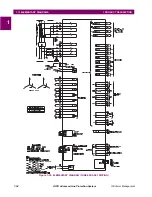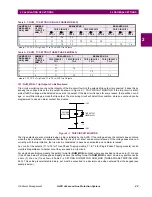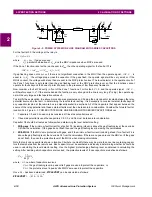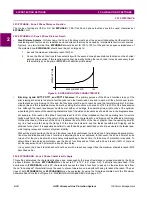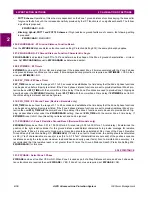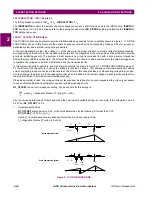
GE Power Management
ALPS Advanced Line Protection System
2-9
2 CALCULATION OF SETTINGS
2.3 PROTECTION SETTINGS
2
2.3 PROTECTION SETTINGS
2.3.1 Z1DISTANCE
101: Z1PHASE - Zone 1 Phase Distance Functions
•
PUTT Scheme: The Zone 1 functions are required in the PUTT scheme to key the transmitter to insure tripping by the
remote terminal. The following setting must be used:
Z1PHASE = YES
•
All Other Schemes: Set Z1PHASE equal to YES if Zone 1 protection for phase faults is desired. Otherwise set
Z1PHASE equal to NO. It is highly desirable to use Zone 1 protection in all schemes because it provides independent,
high speed direct tripping for all phase faults within the reach setting.
102: Z1PREACH - Zone 1 Phase Reach Function
•
Uncompensated Systems: If potential transformers (PTs) are used, use a reach setting that is no greater than 90% of
the positive sequence impedance of the line to be protected. If capacitor voltage transformers are used, refer to the fig-
ure below to determine if additional reduction of the Zone 1 reach is required.
•
Compensated Systems: If series compensation is included in the protected line, or in lines adjacent to the protected
line, the Zone 1 settings need to be modified. If the Z1PLEVDET setting is required, then Z1PREACH should be set
equal to 100% of the positive sequence impedance of the line to be protected. If it is determined that the Z1PLEVDET
setting is not required, then Z1PREACH should be set as for an uncompensated system.
Figure 2–2: ALLOWABLE ZONE 1 REACH (
WHEN USED WITH
CVT
S
)
103: Z1PLEVDET - Zone 1 Phase Level Detector Setting (Series Capacitor Model Only)
The distance functions are measured by comparing the phase relationship of an operate signal (
I·Z - V ) to a polarizing sig-
nal (
V ); where Z is the set reach of the function and I and V are the current and voltage seen by the function. While this
measurement alone is sufficient to provide secure and dependable performance on uncompensated lines, it is not suitable
for application on lines with series capacitors. For example, consider the system shown in the figure above and assume
that the potential source for the ALPS is located on the line side of the series capacitor (C2). For a fault at F3, the imped-
ance seen by a distance function is equal to the line impedance minus the impedance of capacitor C3 (
Zline – Xc3 ). It
might then be assumed that a Zone 1 function could be set to reach 90% of this compensated impedance to provide high
speed direct tripping for the uncompensated portion of the transmission line. However, the function may overreach on the
low frequency transients that could occur for faults beyond the capacitor if the fault current level is insufficient to cause gap
flashing or significant conduction in the MOVs. To overcome this limitation, the operating signal (
I·Z - V) in the ALPS Zone 1
functions must be greater than a set level in addition to meeting the phase angle requirement mentioned earlier. The set
level is directly related to the amount of compensation and the type of protection used around the capacitor.
20
40
60
80
100
10
15
20
25
30
Positive Sequence Source to Line Impedance Ratio, ZS/ZL
Maximum Reach Setting
(% of Positive Sequence Line Impedance)
0
5
0






